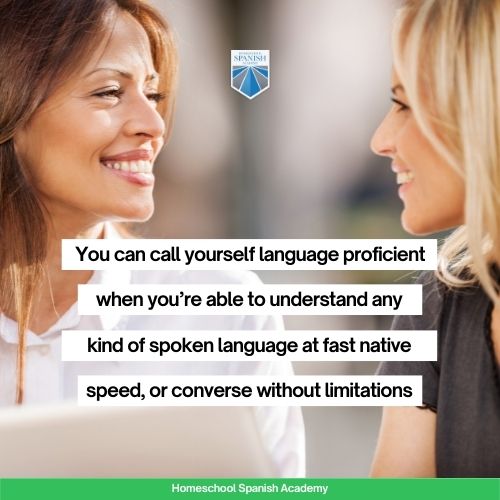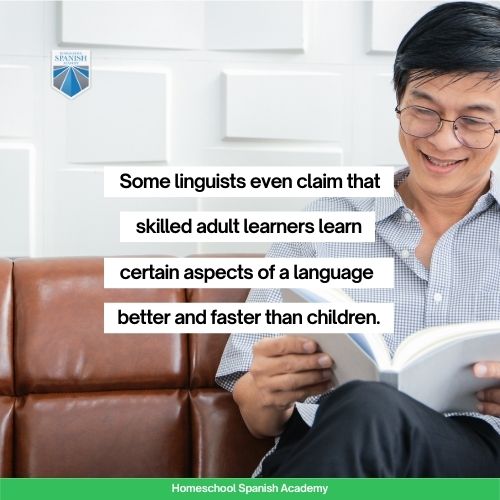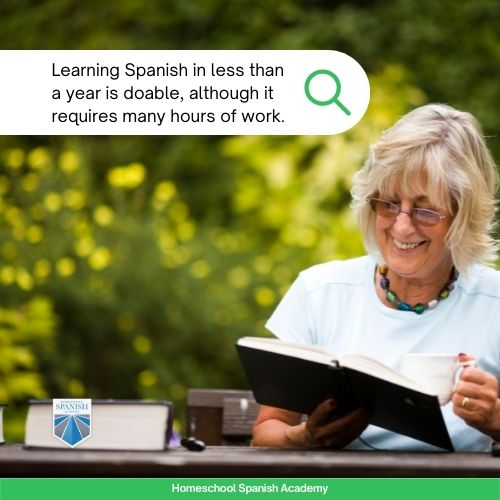
How Fast Can You Learn Spanish? [Real Data]
So, just how fast can you learn Spanish?
How many hours will you need to study before your next no-worry trip to a Spanish-speaking country where you seamlessly interact with locals and order your favorite foods and drinks with ease?
Or how long before you can read Spanish books and watch Spanish movies without a dictionary in hand and pausing every 5 minutes?
Keep reading for the answers to these questions.
Learn what it means to be fluent, how many levels there are in the Spanish language, and how fast you can achieve clearly established goals. I’ll also debunk myths about both children and adult learning and give you handy tips on how to boost your language learning.
Table of Contents:
- What Is Fluency?
- How to Talk About Language Levels
- Can Adults Learn Spanish Fast?
- How Many Hours Do You Need to Become Fluent in Spanish?
- How Do You Learn Spanish Efficiently?
- Start Learning Spanish Fast in 1-to-1 Classes!
What Is Fluency?
Have you ever wondered what it means to be fluent in a language or to be language proficient?
Is it enough to be able to have a conversation in a foreign language?
Or to read a 300-page book?
Or to be able to study in this language?
Linguists agree that “fluency” is a liquid term that means different things to different learners. However, most of them agree that you can call yourself language proficient when you’re able to understand any kind of spoken language at fast native speed, converse without limitations, and carry out complex tasks in your target language.
Nonetheless, not all users aim at language proficiency. Some will feel satisfied if they can simply talk to locals and binge on Spanish series.

Let’s talk about language levels then.
How to Talk About Language Levels
I remember going crazy when I used to receive resumes from potential teachers describing their language levels with a percentage like this:
- Listening: 75%
- Reading: 80%
- Speaking: 45%
- Writing: 55%
What’s the reference point? How did you measure it?
Even if you write to your future employer that you have, for example, a Grundstufe I exam in German, HSk1 in Chinese, DALF in French and FCE in English, they do not necessarily need to know how these certificates translate into your language skills.
Therefore, in 1996, the Council of Europe established the Common European Framework (CEFR) as a standard for the assessment and teaching of languages, and it quickly became a worldwide standard.
CEFR uses a six-level scale of competence: A1, A2, B1, B2, C1, and C2. What you need to know now is that people at the B1 and B2 levels are independent language users.
The Foreign Service Institute (FSI) delivers diplomatic language training to the US government foreign affairs professionals and uses their own proficiency rating from 0 to 5. They also agree that the middle levels mean general language proficiency.
Being an independent language learner is satisfactory for most language learners. If you achieve this level in Spanish, you’ll be able to speak, write, read, and listen well.
Can Adults Learn Spanish Fast?
This is a common concern for adult learners. Let me reassure you—the answer is yes, absolutely! Adult learners can learn a language on a native level.
While it’s true that the older you get, the worse your short-term memory gets, this is compensated for by your life experience, which helps in the learning process.
Some linguists even claim that skilled adult learners learn certain aspects of a language better and faster than children. Why? Because they know more about languages and they have already learned how to learn.
What might you have problems with? Most adults are not good at getting rid of their mother-tongue accent and developing a native-like pronunciation. However, this is not a criterion for success. As long as your speech is intelligible, you can still reach language fluency.

How Many Hours Do You Need to Become Fluent in Spanish?
Language learning cannot be done in a short time. Forget any 30-day challenge Spanish courses. Although time on task and intensity are important, there are no shortcuts to getting language skills well established in your brain.
Foreign Service Institute diplomats spend an average of 1,100 hours, at least four hours a day, five days a week before they are considered fluent. This gives you 55 weeks—one complete year plus 3 weeks. To tell you the truth, they usually spend more hours on some days, and the complete FSI language training lasts 44 weeks.
Now, Instituto Cervantes in Leeds, for example, offers short 30-hour courses to advance your language skills. You need to complete a total of 270 hours of courses to complete the B1 level and start the B2.
Let’s be honest, when you sign up for a language course, these are usually two hours twice a week or less. It means you’ll spend around 67 weeks learning a language.
Are these numbers written in stone?
Can you do it faster?
Yes.
How fast you learn a language also depends on similarities between your target language and your native language.
Spanish is considered one of the easiest languages for the average English speaker, and FSI diplomats usually need between 575 and 600 hours—23 to 24 weeks. If they know other Romance languages, such as French, Portuguese, Italian, Catalan, or Romanian, the time until fluency may be even shorter.
This means that learning Spanish in less than a year is doable, although it requires many hours of work.
However, instead of how fast can you learn Spanish, a better question is how to learn Spanish efficiently. Becoming fluent or conversational should be your goal, and unless you’re under a deadline, there’s no need to rush through the process.

How Do You Learn Spanish Efficiently?
First, you need motivation, self-discipline, and concentration. These may be even more important than cognitive language-learning aptitude.
There’s no one single way to learn Spanish and no single syllabus that fits everybody. There are as many ways to learn and teach a language as there are language learners.
Still, class size matters. The higher your level, the smaller the class should be. Four students or fewer would be ideal. One-to-one language learning is beneficial, as it intensifies the time you spend on a task, increases interaction opportunities, and provides security for learners.
Check out: Top 5 Reasons Small Spanish Classes Are Best
Immersion offers great pay-offs, but it’s more effective at the A2 level when you’re already interacting in the language. On lower levels, focus on spending time using the language, reading, and listening as much as possible.
Hand-picked for you:
- 20 Free Spanish Books, Novels, and Stories in PDF and Printables
- 20+ Free Online Spanish Books for Self-Motivated Beginners
- 22 Spanish Audiobooks with Texts that Delight and Entertain Every Learner
Don’t underestimate grammar instruction, as it helps to learn efficiently and creates awareness of forms that you may use when ready.
Recommended reading: How to Find the Perfect Spanish Workbook
To learn more about strategies for adults to learn Spanish, check out the following links:
- How to Learn Spanish: 5 Easy Strategies That Actually Make You Fluent
- How to Learn Spanish (and Become Fluent) as an Adult
Start Learning Spanish Fast in 1-to-1 Classes!
Find your motivation to study and learn Spanish. Maybe you don’t want to become a diplomat in a Spanish-speaking country, but you can benefit financially from being bilingual in almost every job. According to a study conducted by The Economist, you can earn anywhere from $50,000 to $125,000 extra just by knowing a foreign language alone.
Seeking professional support is one of the smartest things to do when learning something new, and language learning is no exception. A tutor can help you correct subtle mistakes, challenge you more, deepen the knowledge you already have, assess your level, and guide you on the right path.
Let Homeschool Spanish Academy assist you! Sign up for a free trial class to start learning Spanish and see yourself how fast you can learn Spanish in a 1-to-1 conversation! Check out our affordable pricing and flexible programs!

Join one of the 40,000 classes that we teach each month and you can experience results like these

“HSA offers very affordable, quality, one on one classes with a native speaker. My son has greatly benefited from taking classes. We have seen his confidence increase as well as his pronunciation improve, because he learns from a native Spanish speaker. HSA has quick, personal customer service. Our family has been very pleased with our experience so far!”
– Erica P. Parent of 1

“HSA offers very affordable, quality, one on one classes with a native speaker. My son has greatly benefited from taking classes. We have seen his confidence increase as well as his pronunciation improve, because he learns from a native Spanish speaker. HSA has quick, personal customer service. I have appreciated the one on one interaction and teaching that my son gets from his teachers. He has gotten to know his teachers, which has increased his confidence in speaking Spanish. Our family has been very pleased with our experience so far!”
– Maple, Parent of 3

“I love that my children have the opportunity to speak with a live person. They get to practice Spanish in a 1-1 setting while improve their speaking, writing and reading skills during their lessons. HSA is a great way to learn Spanish for all ages! My children are 6, 9 and 11. My oldest two (9 and 11) have been taking classes with HSA for almost 2 years now. They love seeing their teacher each week. They understand the importance of learning several languages. I’ve seen them grow and learn with HSA. I’m excited to see how they will improve the more classes they take. I highly recommend them. You can’t bet learning and speaking with a live teacher. I’ve tried other programs. It’s just not as motivating.”
– Karie Ann, Parent of 3
Want more free Spanish resources and learning strategies? Check these out!
- Language Learning with Netflix: How to Use the Chrome Extension
- Turn Your Life Around: From Passive Bilingualism to Fluency!
- The Beauty of Spanish Sign Language
- Multilingual Mastery: How Many Languages Can You Learn?
- The Journey of Becoming Trilingual
- Saying It Like a Native: Exploring Spanish Idioms
- Adapting Education: Spanish Lessons for All Learning Styles
- Speak Up! Enhance Your Conversational Spanish
- 10 Homeschooling Styles You Need to Explore in 2023 - March 14, 2024
- Home Sweet Classroom: Creating Engaging Spanish Lessons at Home - October 13, 2023
- Expressing Appreciation in Spanish on World Teachers’ Day - October 5, 2023





